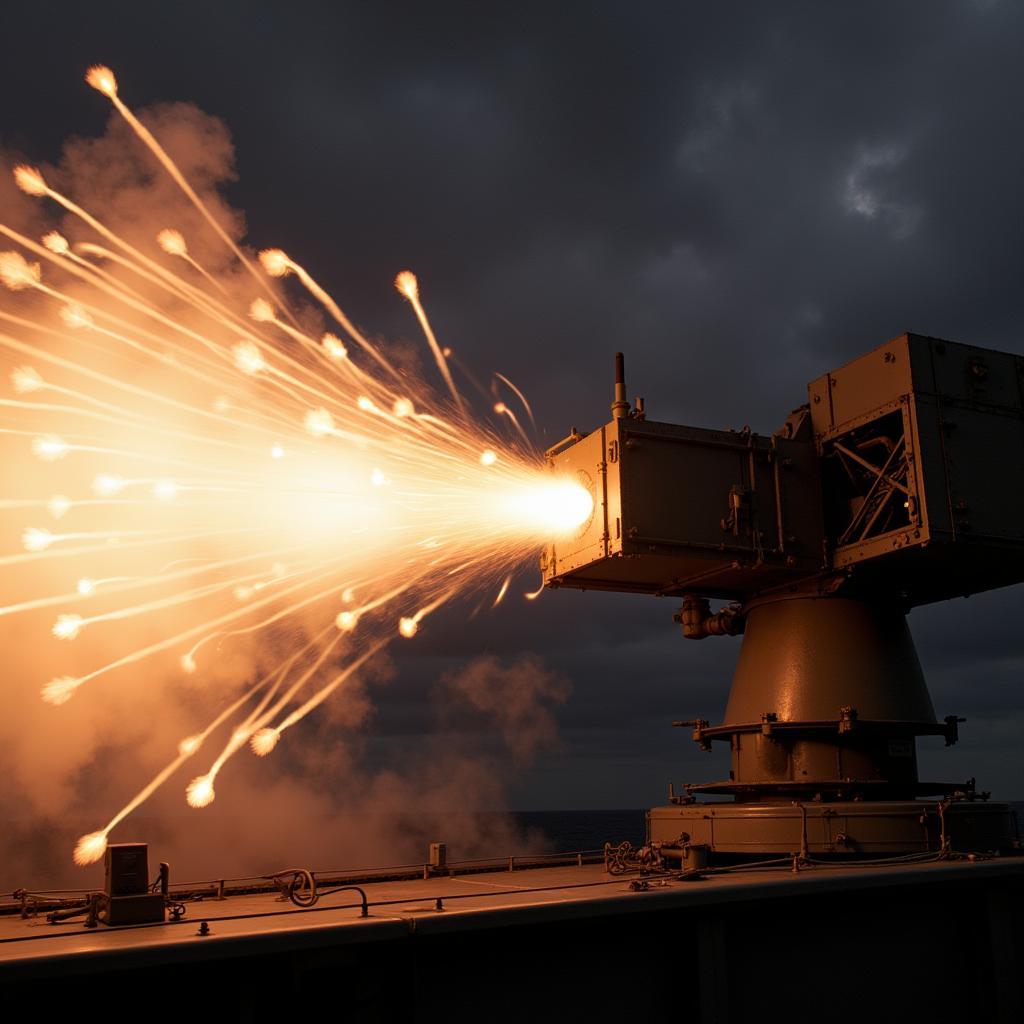The CIWS, or Close-In Weapon System, is a modern marvel of naval defense, capable of shredding incoming missiles with a terrifying barrage of bullets. But how would this system, designed to counter high-speed, guided threats, fare against the aircraft of World War II? Could a CIWS effectively defend against a squadron of dive bombers or a formation of torpedo bombers? Let’s analyze the capabilities of the CIWS and the characteristics of WWII aircraft to determine if this modern defense system would prevail against the airborne threats of a bygone era.
The CIWS: A Modern Guardian
 CIWS firing a barrage of rounds
CIWS firing a barrage of rounds
The CIWS, often referred to as the “R2-D2” of warships due to its distinctive radar dome, is a last line of defense against anti-ship missiles. Its primary purpose is to engage and destroy incoming threats that have penetrated other layers of a ship’s defenses. Here’s a breakdown of its key features:
- High Rate of Fire: The CIWS boasts an incredibly high rate of fire, typically around 4,500 to 5,000 rounds per minute. This creates a dense wall of projectiles, significantly increasing the probability of hitting a target.
- Radar-Guided Precision: Equipped with sophisticated radar systems, the CIWS can detect, track, and engage targets with high accuracy. The system automatically calculates the target’s trajectory and adjusts its fire to ensure a hit.
- Limited Range: The CIWS is designed for close-in defense, meaning it has a limited effective range. Depending on the specific model, this range typically falls between 2 to 5 miles.
- Designed for Modern Threats: The CIWS is optimized to engage small, fast-moving, and maneuverable targets like anti-ship missiles.
WWII Aircraft: A Different Breed
 Formation of WWII bombers in flight
Formation of WWII bombers in flight
World War II aircraft, while formidable in their time, were significantly different from modern threats. Here are some key characteristics:
- Larger Size and Slower Speeds: Compared to missiles, WWII aircraft were much larger and flew at considerably slower speeds, making them easier to track and target.
- Limited Maneuverability: While some fighters were agile, bombers and torpedo bombers were not known for their maneuverability, especially when compared to modern aircraft.
- Formation Flying: WWII aircraft often attacked in formations, which could present a larger target area for the CIWS.
Would the CIWS Prevail?
Considering the strengths and limitations of both the CIWS and WWII aircraft, the modern defense system would likely hold a significant advantage. Here’s why:
- Target Size and Speed: The larger size and slower speeds of WWII aircraft would make them relatively easy targets for the CIWS’s radar and rapid-fire cannons.
- Formation Flying: While attacking in formation could present a larger target, it also means that multiple aircraft could be caught in the CIWS’s barrage.
- Technological Superiority: The advanced radar and fire control systems of the CIWS represent a significant technological leap over the radar and targeting systems available during WWII.
However, there are factors that could pose challenges for the CIWS:
- Sheer Numbers: WWII air raids often involved large numbers of aircraft. While the CIWS could engage multiple targets, it could be overwhelmed by a sustained attack.
- Different Attack Profiles: Dive bombers, attacking from steep angles, could present a challenge as they would be within the CIWS’s firing envelope for a shorter period.
Conclusion: A Likely Victory for Modern Technology
While not without its challenges, the CIWS would likely prove highly effective against the aircraft of World War II. The system’s speed, precision, and firepower represent a significant technological advantage over the aircraft of that era. However, the sheer number of aircraft involved in a WWII air raid could potentially overwhelm even the most advanced defense systems.
Need help navigating the complexities of marketing and advertising? Contact us today!
Phone: 02838172459
Email: [email protected]
Address: 596 Đ. Hậu Giang, P.12, Quận 6, Hồ Chí Minh 70000, Việt Nam.